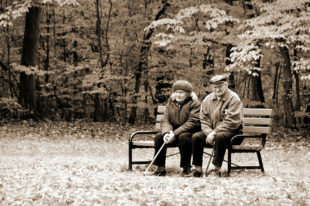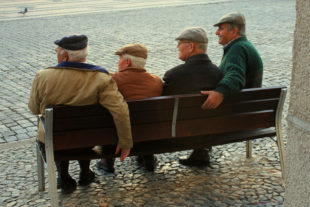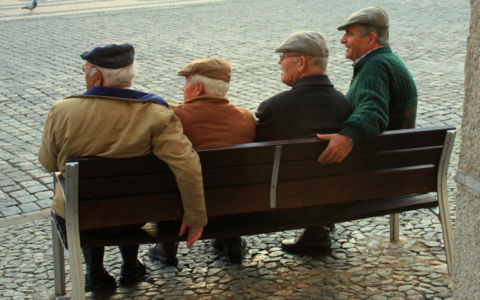Geriatric Problems and the Impact it has on Life
Christian Counselor Spokane
If you or a loved one are experiencing the effects of aging, you may be able to relate to the contents of this article. Below we’ll discuss some common yet overlooked geriatric problems, how they affect one’s life, and what can be done to help those who are struggling.
Common Geriatric Problems
Let’s take a look at some of the most commonly seen issues that affect the elderly and those who are aging.
Depression
Depression in the elderly population is a major public health problem. It has a high pervasiveness, is habitually co-morbid with medical ailments, impacts negatively on quality of life, upsurges the number of visits to diverse medical services, and brings a high risk of suicide, especially in men.
 Imaging studies have increased our understanding of the biological mechanisms of depression in the elderly. Depression is at times difficult to diagnose in this demographic. It should be distinguished from dispirited states and its treatment involves awareness of specific functional changes that occur in this age group.
Imaging studies have increased our understanding of the biological mechanisms of depression in the elderly. Depression is at times difficult to diagnose in this demographic. It should be distinguished from dispirited states and its treatment involves awareness of specific functional changes that occur in this age group.
Geriatric depression is more somatic and less ideational than depression in other age groups. Dire treatments with various antidepressant medications, augmentation strategies, electroconvulsive treatments, and psychotherapy must be coupled with maintenance strategies to prevent recurrences, which are common (Serby & Yu, 2003).
Serby & Yu (2003) explain that depression in individuals aged 65 years and older is a main public health problem. It causes distress to many who go undiagnosed and untreated, and it burdens families and associations who provide care for the elderly by disabling those who might otherwise be self-regulating and prolific.
Use of medical outpatient services rise. Depressed older people refer to their general physician two to three times more often than non-depressed elders. Prompt acknowledgement, diagnosis, and commencement of treatment for depression in older people present prospects for enlightening their quality of life, averting suffering or untimely death, and preserving prime stages of function and independence (Serby & Yu, 2003).
Anxiety
Another problem that elders face is anxiety. Unwarranted anxiety that causes distress or that inhibits daily activities is not a usual part of aging, and can lead to a variation of health problems and declined functioning in daily life.
Between 3% and 14% of older adults meet the criteria for a diagnosable anxiety disorder, and a recent study from the International Journal of Geriatric Psychiatry found that more than 27% of older adults under the care of an aging service provider have symptoms of anxiety that may not amount to diagnosis of a disorder, but significantly impact their functioning.
 Comparable to depression, anxiety disorders are often unrecognized and undertreated in older adults. Anxiety can worsen an older adult’s physical health, decrease their ability to perform daily activities, and decrease feelings of well-being (http://www.mentalhealthamerica.net/anxiety-older-adults).
Comparable to depression, anxiety disorders are often unrecognized and undertreated in older adults. Anxiety can worsen an older adult’s physical health, decrease their ability to perform daily activities, and decrease feelings of well-being (http://www.mentalhealthamerica.net/anxiety-older-adults).
Anxiety in older adults may be linked to several important risk factors. These include, among others:
- Chronic medical conditions (especially chronic obstructive pulmonary disease [COPD], cardiovascular disease including arrhythmias and angina, thyroid disease, and diabetes)
- Overall feelings of poor health
- Sleep disturbance
- Side effects of medications (i.e. steroids, antidepressants, stimulants, bronchodilators/inhalers, etc)
- Alcohol or prescription medication misuse or abuse
- Physical limitations in daily activities
- Stressful life events
- Negative or difficult events in childhood
- Excessive worry or preoccupation with physical health symptoms
(Taken from http://www.mentalhealthamerica.net/anxiety-older-adults)
According to Surakarn, Saenubol, & Charupheng (2016), the rate of mixed anxiety-depressive disorder among the elderly has become extremely high, unavoidably worsening their ability to perform everyday tasks as well as quality of life. Elderly people are more at threat of developing depression while wrong treatments can cause additional dilemmas to the diagnosed individuals and people around them, eventually leading to other social problems.
Nevertheless, the associated symptoms of depression and anxiety affect the decline of trained ability, quality of life, and death more than the development of depression and anxiety individually. The effects can be more severe and impact the long-lasting uncontrolled conditions of the patient. The elderly developing depressive disorder incline to inhabit on sadness and the feelings of hopelessness, negativity, low self-esteem, and self-blame (Surakarn et al., 20016).
Anxiety in elderly people refers to the state where one is excessively anxious, forgetful with problems sleeping, and feelings of distress accompanied by the symptoms of nervous system overload, which ultimately lead to heart palpitations, shortness of breath, sweating, numbness in hands or feet, abdominal tension, etc.
Anxiety disorders are frequently misdiagnosed as other types of illness since most patients are inclined to inform medical physicians of their physical conditions such as being out of breath, fatigue, exhaustion, nausea, angina, headache, frequent urination, abdominal discomfort, gassiness, tight throat feeling, shaky hands and body, numbing, cold hands and feet.
These symptoms can be accompanied by mental indications such as stress, uneasiness, disarrangement of thoughts, paranoia, being easily ill-tempered, distracted, unfocused and forgetful, jumpiness, insomnia or night dreads. These signals can lead to anxiety disorders (Surakarn et al., 2016).
Elders who experience depression also experience weight loss, heart palpitations, nausea, and neck pain, while some become exceedingly stressed and vomit. There are many cases where individuals are forgetful who exhibit sadness in their eyes. There are other physical symptoms relating to sleeping problems such as night terrors, broken sleep, staying in bed all day, while some stop talking or moving with conditions of parasomnia such as sleep talking, as well as crying when being left alone.
Emotions and feelings of elders who suffer from depression and anxiety disorders may be articulated inversely and have certain effects on their caregivers and the people around them. Elders who go through depression and anxiety disorders frequently display fears, whether it’s a fear of being left alone with no one to take care of, fear for the harsh life in the future, fear of being a burden for others, etc. Some become highly stressed and anxious while others are very sensitive and seek for attention, with suicidal ideation in some cases (Surakarn et al., 2016).
Most elders who suffer from depression and anxiety often express behavioral symptoms centering on their emotional state. Several will complain about their misfortune for having to go through a sickness and become a burden for their children. There are countless cases where the elders turn to alcohol and become more belligerent and disagreeable.
There are those that will reprimand or decline to talk or answer to others, some withdraw from a discussion and decline to help themselves or partake in activities they once did. There are those that will display uncommon behaviors such as crying after speaking about a relative that has passed on, with symptoms of memory loss in certain cases. There are those that are accompanied by other ailments such as herniated disease, stroke, memory loss, on top of the symptoms of depression and anxiety they already suffer (Surakarn et al., 2016).
Physical Health and Symptomology
In elderly people, depression is a fairly common psychiatric symptom, and even though the occurrence of major depression is not high, that of minor depression and a mild depression is relatively high. Depression in elderly people has diverse characteristics compared to depression in younger people.
 For instance, depressed mood and sadness have been stated to be less prominent in the elderly than in the young. Depression in elderly people can also be categorized by a decrease in social interaction, withdrawal, hypochondria, apathy, and decreased stamina (Murayama, Endo, Inaki, Sasaki, Fukase, Ota, & Tagaya, 2016).
For instance, depressed mood and sadness have been stated to be less prominent in the elderly than in the young. Depression in elderly people can also be categorized by a decrease in social interaction, withdrawal, hypochondria, apathy, and decreased stamina (Murayama, Endo, Inaki, Sasaki, Fukase, Ota, & Tagaya, 2016).
According to Junprasert, Polyota, Piasai, & Chaiakkarakan (2016) the physical health of elderly people is in the weakening phase where signs of ailments are apparent, permitting instant assistance and treatment and/or appropriate medical attention that needs to be provided. Conversely, variations in mental and emotional conditions might be more difficult to detect or comprehend. Moreover, some elders still continue to feel association of friendships with those who may live in diverse locations and times.
In contrast, some elders view the past with a sense of desolation, being repentant of their faults. The feeling of desolation also includes anger, which may be communicated as hatred and insults towards others as a way to hide their own low self-esteem. Consequently, elderly people may suffer from an excessive sense of desolation that can affect their psychological well-being and lead to consequences such as depression and anxiety (Junprasert et al., 2016).
Equally important to a healthy physical condition is good mental health, and people in the elderly’s life can help prevent such symptoms from causing any harm to their lives. Efficiency and eminence of elderly care thus hinge on a network of the family members of the elderly and individuals who are close to the elderly.
 When considering the living condition where elderly people share accommodation with family members today, it is found that the size of the family is smaller, with approximately three members per one household with increasing rate of senior individuals living alone.
When considering the living condition where elderly people share accommodation with family members today, it is found that the size of the family is smaller, with approximately three members per one household with increasing rate of senior individuals living alone.
In 2002, the number of senior people living alone account to 6.3%, while 15.9% were living with a partner or spouse. In 2014, the number of elderly living alone increased to 8.7% with 18.8% living with partner or spouse. Such statistical data reflects the tendency of present and future eldercare and its reliance on community participation, particularly the group of elderly people who live alone without any assistance from in-home caregivers (Junprasert et al., 2016).
According to Taqui, Itrat, Oidwai, & Qadri (2007), depression is acknowledged as a grave public health concern in developing countries and the Global Burden of Disease study showed that depression will be the single leading cause of Disability Adjusted Life Years by 2020 in the developing world.
Depression is the most common psychiatric disorder among the elderly which can manifest as major depression or as minor depression characterized by a collection of depressive symptoms. Many studies have indicated severe under-recognition and under-treatment of depression in the elderly, even in developed counties.
Between the years 2000 and 2050, the worldwide proportion of persons over 65 years of age is expected to more than double, from the current 6.9% to 16.4%. As health care facilities improve in countries, the proportion of the elderly in the population and the life expectancy after birth increase accordingly.
This is the trend which has been seen in both developed and developing countries. It is commonly believed that the majority of the elderly population resides in developed countries. However, this is a myth, as about 60% of the 580 million older people in the world live in developing countries, and by 2020, this value will increase to 70% of the total older population (Taqui et al., 2007).
Poor Quality of Life
In a study conducted by Djernes (2006), cognitive impairment and dementia were associated with depressive symptoms and depressive disorders. Chronic somatic diseases and pain in persons admitted to nursing homes predicted depression.
Health-related functional impairment, especially in personal and instrumental Activities of Daily Living (ADL) was a risk factor for onset of depressive symptoms and depressive disorders. Chronic somatic diseases were strongly associated with the onset of depressive disorders and depressive symptom cases, social distress factors were associated with depressive symptom cases.
Social isolation, loss of close social contacts or a confidant, and low emotional support from children were potential risk factors for the onset of depressive symptoms and depressive episodes in later life. The study also identified the presence of alcohol-related problems and the association with depressive symptom cases.
The commonly experienced stresses and distresses in later life, including neighborhood problems, were related to depressive symptoms and depressive disorders. Anxiety symptoms and neuroticism were associated with depressive symptom cases and depressive disorder, and generalized anxiety disorder was associated with minor depression in the very old (80 years of age) (Djernes, 2006).
Djernes (2006) also noted the combination of depression and anxiety and the rise with higher severity levels of both depressive symptom cases and generalized anxiety disorder, and this mixed depression–anxiety was twice as likely in women compared with men.
In assisted living, depression was associated with agitation and psychosis. Low educational level was associated with depressive disorders and depressive symptom cases. Higher educational level was associated with less depression; one study showed that major depression was often an exacerbation of a chronic mood disturbance with roots in longstanding vulnerability factors. A depressive disorder was associated with poor life satisfaction, dissatisfaction with life, and worse indexes of quality of life (Djernes, 2006).
Djernes (2016) further discussed the increased risk of death and how the risk was seen in both genders with major depression, in both demented and non-demented depressed individuals, except depressed women without dementia.
A high level of depressive symptoms was associated with an increased mortality rate, which was unmodified by a high level of social relations. Increased mortality was also associated with a high level of depressive symptoms in assisted living.
Other factors and predictors associated with depression consisted of: vision and hearing problems, poverty or low income, poor somatic health, physical disability, social isolation, sleep disturbances, insomnia, waking up not feeling rested, taking sleep medications, dissatisfaction with social support, subjective need for care, social support deficits, lack of social activities in private households and nursing homes, and receiving home nursing or home help. Singles were more likely to have depressive symptoms than people not living alone, and behavioral disturbances were frequently associated with depression in nursing home residents (Djernes, 2006).
Christian Counseling for Geriatric Problems
Regrettably, depression can overcome many of us, especially late in life. Although it is known that the Lord will comfort us and guide us, depression is problematic and needs to be targeted.
The Lord puts certain people in our lives to help us move forward to the next stepping stone and to assist in overcoming those barriers that keep us from living a quality life.
Engaging in counseling can be the guidance to the next stepping stone, to stay on path, and to reach the journey the Lord has for each and every one of us with peace and the absence of adverse distresses. Together, we can move forward and re-discover the true meaning of life and overcoming the storms.
References
Djernes, J. K. (2006). Prevalence and predictors of depression in populations of elderly: a review. Acta Psychiatrica Scandinavica, 113(5), 372-387. doi:10.1111/j.1600-0447.2006.00770.x
Junprasert, T., Polyota, T., Piasai, P., & Chaiakkarakan, N. (2016). Depression and Anxiety in the Elderly: Formulation and Development of Preventive Model through Community Participation. International Journal Of Behavioral Science, 11(2), 77-92.
Murayama, N., Endo, T., Inaki, K., Sasaki, S., Fukase, Y., Ota, K., & … Tagaya, H. (2016). Characteristics of depression in community-dwelling elderly people as indicated by the tree-drawing test. Psychogeriatrics, 16(4), 225-232. doi:10.1111/psyg.12142
Serby, M., & Yu, M. (2003). Overview: Depression in the Elderly. Mount Sinai Journal Of Medicine, 70(1), 38.
Surakarn, A., Saenubol, K., & Charupheng, M. (2016). Depression and Anxiety Disorders in the Elderly: Stories from the Caregivers. International Journal Of Behavioral Science, 11(2), 63-76.
Taqui, A. M., Itrat, A., Qidwai, W., & Qadri, Z. (2007). Depression in the elderly: Does family system play a role? Across-sectional study. BMC Psychiatry, 757-68. doi:10.1186/1471-244X-7-57
http://www.mentalhealthamerica.net/anxiety-older-adults
Photos
“Sit here with me,” courtesy of Kamil Porembinski, Flickr Creative Commons, CC0 License; “Mist,” courtesy of Eduardo M., Flickr Creative Commons, CC0 License; “Look at that!” courtesy of Gabriel Rocha, Flickr Creative Commons, CC0 License; “Bicycle,” courtesy of Michl Dreier, Flickr Creative Commons, CC0 License





